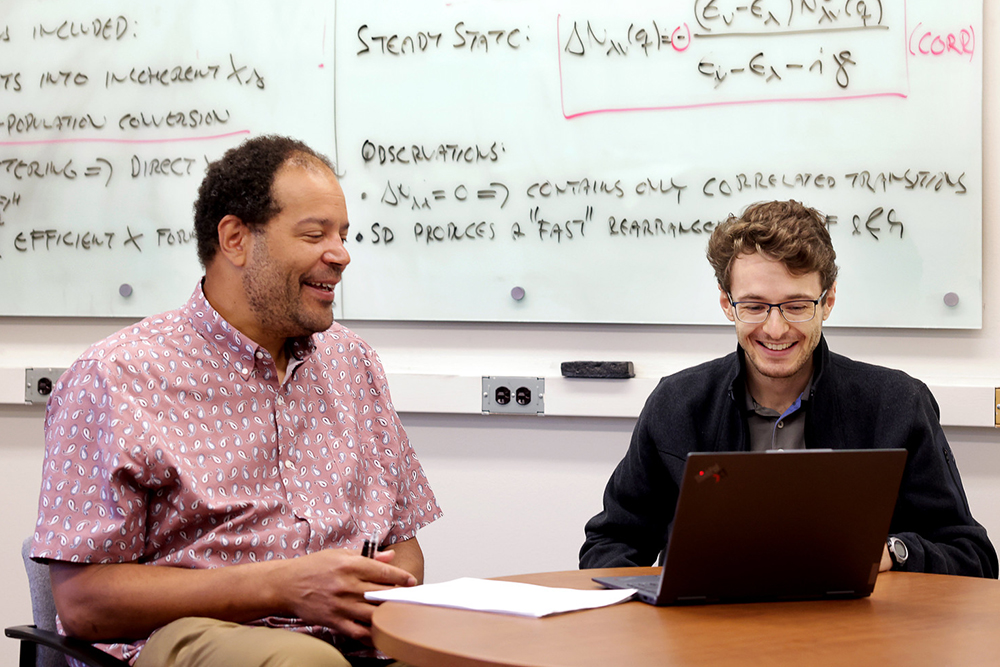Shaping the quantum future with lightwave electronics

Imagine electronics that operate literally a million times faster and sensors that are so accurate they can track objects that are smaller than a single molecule. In a recent review published in Nature Reviews Materials, a team of quantum researchers from the University of Michigan and the University of Regensburg share their grand vision for how these possibilities can become reality with lightwave electronics.
“With lightwave electronics, we’ll be able to access a completely new world of quantum phenomena,” said Prof. Mackillo Kira, co-author on the review and co-Director of the Michigan Quantum Institute. “We could even visualize what’s happening inside quantum materials, which is extremely important to develop the quantum technology further.”
With lightwave electronics, we’ll be able to access a completely new world of quantum phenomena.
Prof. Mack Kira
The potential for lightwave electronics to revolutionize the future of technology was acknowledged on October 3rd when foundational, mostly atom-based work won the 2023 Nobel Prize in Physics. Pierre Agostini, Ferenc Krausz, and Anne L’Huillier received the top award “for experimental methods that generate attosecond pulses of light for the study of electron dynamics in matter.”
“This year’s Nobel Prize was awarded to the researchers that first generated attosecond pulses,” said Markus Borsch, ECE PhD student and first author on the paper. “These pulses are the foundation of the field of attosecond science and have been very successfully applied to study the electron dynamics in atoms and molecules on ultimately fast timescales.”

Kira and Borsch’s research is closely related to this work, scaling up from individual atoms to semiconductor technology. Their recent review of the field was featured in the Nature Reviews Materials collection celebrating this Nobel Prize.
“Our work has been expanding the horizons of lightwave electronics to apply it also in semiconductors,” Kira said. “I am very pleased to see this important quantum science and technology frontier acknowledged because it has made amazing progress over the past decades.”
As the speed and efficiency of conventional electronics reaches the limits of physical laws, researchers have been exploring alternative methods for controlling electrons, which define the key properties of materials. But the dynamic interactions between electrons that result in quantum states have remained too difficult to control.
Lightwave electronics, however, use the oscillating electric field of light to move charge carriers faster than a single cycle of light. This could seamlessly convert quantum states between light and matter, resulting in quantum chips that are faster, more efficient, and more tuned to emergent quantum effects. Specifically, by enabling an electronics–optics interface, semiconductor-compatible technology could be a million times faster than existing electronics.
“One application of quantum chips could be extremely precise quantum sensors,” Kira said. “You could study extremely tiny objects, smaller than a single molecule. You could monitor the environment by tracking and quantifying even trace amounts of chemicals. You could put quantum sensors on the satellites to track weather patterns and climate change with sensitivity no classical means can match.”
One application of quantum chips could be extremely precise quantum sensors.
Prof. Mack Kira
Researchers are also exploring how this quantum technology can be integrated with current electronics, rather than completely replacing it. Many ECE faculty at U-M are already experimenting with these quantum augmentations.
- Prof. Alex Burgers researches the quantum control of single atoms to advance understanding of quantum systems and impact applications of quantum information science, including quantum sensors.
- Prof. Zetian Mi is looking to discover materials that can both apply lightwave electronics and also support artificial photosynthesis, which could revolutionize clean energy.
- Prof. Parag Deotare is developing excitonic systems that will advance quantum metrology as well as efficient exchange of quantum information.
- Prof. Zheshen Zhang is pushing the frontiers of quantum sensing beyond classical limitations.
“We’re also exploring quantum phenomena like ultrafast switching of quantum information, all-optical band-structure reconstruction, and attoclocks for measuring quantum interaction dynamics,” Kira said.
In addition to Kira and Borsch, the review, Lightwave electronics in condensed matter, is authored by Manuel Meierhofer and Rupert Huber.
 MENU
MENU 
